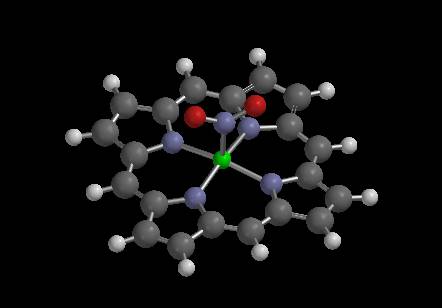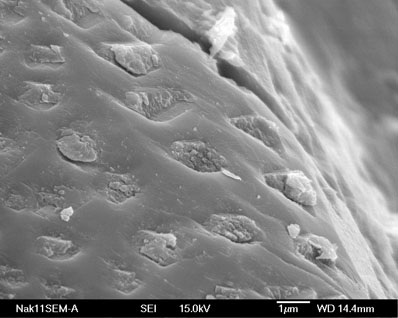An Article In Meteorite-Times Magazine
by Robert Verish
![]()
An Article In Meteorite-Times Magazine
by Robert Verish
Evidence of Life Found in Another Martian Meteorite!
Another Mars rock, the Los Angeles meteorite, has fossil evidence that suggests life once existed on Mars.
Abstract:
Researchers using Raman Spectrographic equipment (like the setup depicted in the above image) have found
"disordered graphite " and "metalloporphyrin " in the Los Angeles Martian meteorite (diabasic shergottite).
The fact that these compounds have a biotic origin is not questioned. Although these two compounds have been
dismissed as being terrestrial contaminants, it begs the question, "Where are all the other compounds that would
accompany this type of terrestrial contamination?" Given the absence of additional evidence for recent terrestrial
contamination, it is my contention that "disordered graphite" and "metalloporphyrin" are actually fossil residue,
having a biological origin which predates the impact that launched the host rock from the surface of planet Mars.
NASA presented their findings in greater depth before the American Geophysical Union Meeting (January 2010) in San Francisco. At the meeting, John McKay, the principal investigator for the original findings regarding AH84001 presented in 1996, declared that before the end of 2010 "definitive proof" will be announced. He stated that recent advancements in instrumentation have resulted in breakthroughs in our ability to identify "biomorphs". The "biomorph" features discovered in the Yamato 593 meteorite look identical to those found inside the Allen Hills and Nakhla meteorites, according to McKay.
Because of these recent findings, there has been a shift in the "Mars life strategy": NASA's original strategy was to "follow the water", then the strategy shifted to "follow the carbon." The strategy now, however, simply reads "find direct evidence for seeking out life". That role will first fall to the Mars Science Laboratory rover undergoing final assembly for launch in September 2011.
It is my purpose in this article to bring attention to another Mars rock meteorite, the Los Angeles meteorite (a diabasic shergottite), and to suggest that it, too, should be re-examined based upon findings that were originally reported nearly ten years ago. Given the "recent advancements in instrumentation", this re-examination of the Los Angeles martian meteorite is warranted. In fact, before the next NASA science platform is launched to Mars in order to "search for any and all signs of life", it would be prudent to re-examine as many martian meteorites as is possible.
Typical arrangement of Carbon molecules when in the form of Graphite
The sample of LA that was used in this survey (termed by the researchers as "Stone#2") was obtained from UCLA. This means that the sample came from the type specimen that this author submitted to UCLA in 1999. Having personally cut this type specimen on my own rock-saw, I can attest to the fact that this was far from a "clean room" operation. Nevertheless, having also personnally witnessed an SEM examination at UCLA of an interior slice that was cut from Stone #1 in clean-room lab conditions, I can confirm that a ruby-colored "crystal" of metalloporphyrin was also found in the interior of this other stone, as well.
Admittedly, we didn't appreciate the significance of this minute, ruby-red speck. It wasn't until several years later that I realized we had observed metalloporphyrin in "Stone#1" after I saw the images on this website:
Preliminary Raman spectroscopic survey on a Martian meteorite - Los Angeles
which then led me to this webpage:
Terrestrial life (contaminate) on Martian meteorite Los Angeles
which is the Raman spectroscopic study led by Alian Wang.
The results of this "survey" were published in 2001 under the title:
Preliminary Raman spectroscopic survey on a martian meteorite – Los Angeles in Lunar and Planetary Science XXXII (2001) - 1427.pdf
Although the title called this a "Preliminary survey", it was still a very thorough examination that identified all of the mineral constituents, as well as, contaminants, presumably all terrestrial. What I found intriguing was the emphasis placed on describing two of these "contaminants":
1) the disordered graphite - which was always associated with the masses of secondary hematite.
and
2) the metalloporphyrin - which were individual grains that looked like minute, ruby-colored crystals.
Since these compounds are known to have biologic origins, it is understandable that some space in the paper be taken to describe their occurrence. But their prominence in the abstract, particularly the images of the ruby-colored metalloporphyrin grains, has led me to think that the significance of their presence in this meteorite was being intentionally understated, in order to allow the reader to draw their own conclusion.
In order for me to draw my own conclusion, I need answers to certain questions.
For instance, if the Raman spectroscope was so sensitive as to detect and properly identify minute masses of carbon compounds that are, at best, ephemeral vestiges of once living organisms, then why didn't the spectroscope detect a long list of hydrocarbon compounds, such as proteins, lipids, cell-walls, etc., in other words, the remains of the purported terrestrial organisms that "produced these two contaminants"?
How long does it take to form disordered graphite from once living organisms? Among all of the Martian meteorites, the Los Angeles stones are one of the freshest, having one of the lowest terrestrial residence times (~5k-9k years). Is this long enough for a terrestrial organism to decompose into "disordered graphite"?
In the absence of other hydrocarbons, wouldn't the sole-presence of minute, crystalline grains of metalloporphyrin be exactly the kind of vestigial substance from once living organisms that could survive in the vacuum of space over long geologic time?
For now, until a re-examination of the Los Angeles meteorite with the newly advanced instrumentation can prove otherwise, I can only conclude that LA is too fresh, too pristine (lacks a wide variety of contaminants from terrestrial organisms) and too rich in the exact carbon compounds that you would expect to survive the transit through space from Mars to Earth.
Ordered Graphite - typical "narrow" response with Raman spectrograph
Disordered Graphite - typical "wide" response with Raman spectrograph
Over the intervening decade since the above "preliminary survey" was published, NASA has never contacted me (the main mass holder of Los Angeles) for additional samples for a more thorough examination with the advanced analytical instrumentation they have developed. I find this curious, because their oft-stated strategy was to "Follow the Carbon"! In fact, as recently as January 2010 at the AGU Meeting in San Francisco, John McKay was quick to congratulate themselves (NASA) for having followed through on this strategy, because when it came to "following the carbon", there was (and I quote) "a lot of carbon in Nakhla!"
But in my view, NASA has fallen well short of their goal to follow the carbon to Mars, when they failed to follow the carbon trail just this short distance to Los Angeles.
Diabasic Shergottite - Available for Re-examination
REFERENCES:
Preliminary Raman spectroscopic survey on a martian meteorite – Los Angeles in Lunar and Planetary Science XXXII (2001) - 1427.pdf -
by Alian Wang, Karla E. Kuebler, John Freeman, Bradley L. Jolliff, Dept. Earth & Planetary Sciences, Washington University, St. Louis, MO, 63130 (alianw@levee.wustl.edu)
Google docs - Preliminary Raman spectroscopic survey on a martian meteorite – Los Angeles,
by Alian Wang, Karla E. Kuebler, John Freeman, Bradley L. Jolliff, Dept. Earth & Planetary Sciences, Washington University, St. Louis, MO, 63130 (alianw@levee.wustl.edu)
(If the previous Reference has expired, try this more permanent link.)
Preliminary Raman spectroscopic survey on a Martian meteorite - Los Angeles -
Which is a Raman spectroscopic study led by Alian Wang.
The purpose of this survey was to "identify the main mineral phases of the Los Angeles Mars-rock, as well as accessory phases, even though they might be terrestrial alteration or
contaminants":
Terrestrial life (contaminate) on Martian meteorite Los Angeles -
Which depicts images of the metalloporphyrin "contaminants" found by Alian Wang.

Metalloporphyrin : Definition from Answers.com
metalloporphyrin ( m?'talo'pörf?r?n ) ( biochemistry ) A compound, such as heme, consisting of a porphyrin combined with a metal such as iron, copper...

Disordered graphite
- Graphite surface disorder detection using in situ Raman microscopy - BY Laurence J. Hardwick, Hilmi Buqa and Petr Novák
in: Solid State Ionics - Volume 177, Issues 26-32, 31 October 2006, Pages 2801-2806
Fig. 4. In situ Raman spectra series of disordered graphite of the four points from open circuit potential (3000 mV) to 550 mV (top) and from 500 mV to 220 mV (bottom). Spectra are shifted arbitrarily up the intensity axis. The arrows on the left-hand side of each quad indicate the direction of the scan.

Alian Wang - Mission to Mars - Alian also uses Raman spectroscopy for another passion of hers: the study of Martian meteorites... ...



SPACEFLIGHT NOW
- Three Martian meteorites triple evidence for Mars life - BY CRAIG COVAULT
Posted: January 9, 2010
SPACEFLIGHT NOW - Martian meteorite surrenders new secrets of possible life - BY CRAIG COVAULT
Posted: November 24, 2009
Technology Review - Delta V - Wednesday, December 02, 2009 - Fresh Evidence of Ancient Life on Mars?
A new study says it's the best explanation for materials found in a meteorite, but not everyone agrees.
Life on Mars NewsWire: Recent Articles - News that scientists had found evidence of life in a Mars meterorite had leaked out, ...
For for more information, please contact me by email:
Bolide*chaser

